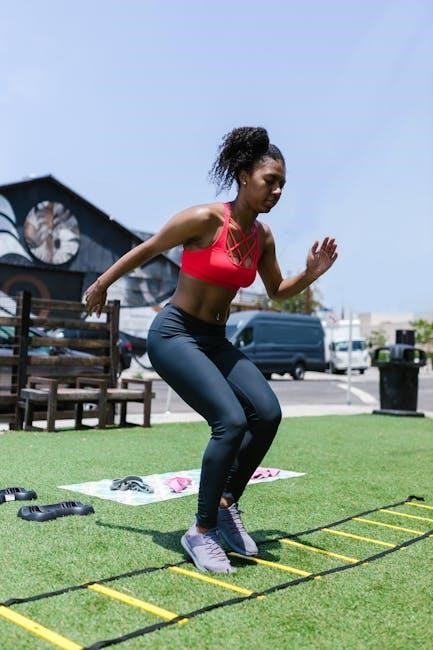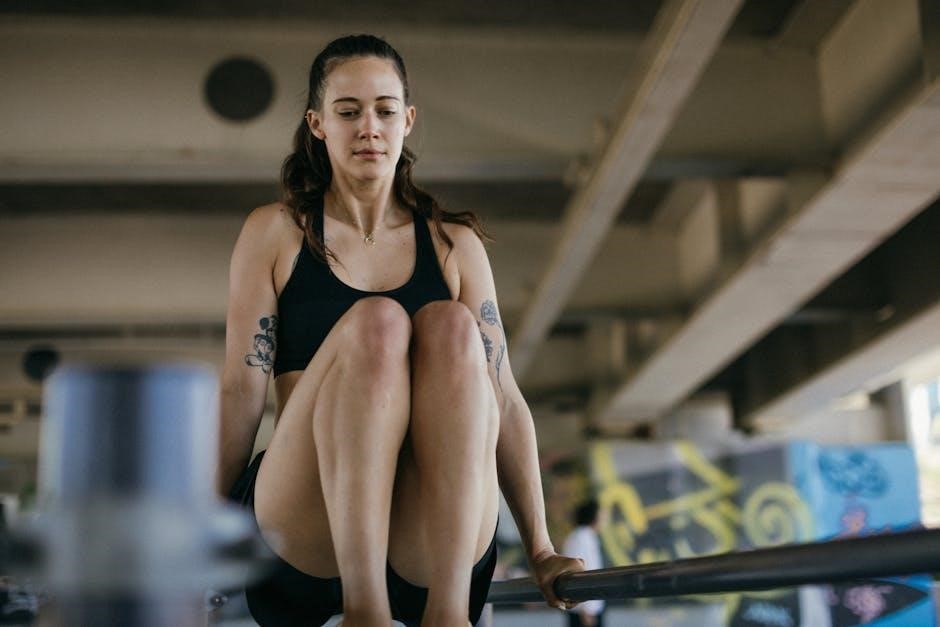Bodyweight training is a versatile and effective way to build strength, flexibility, and endurance without equipment. It enhances physical fitness and improves mobility for all fitness levels.
Overview of Bodyweight Training
Bodyweight training is a form of exercise that uses an individual’s weight as resistance to build strength, endurance, and flexibility. It is highly adaptable, requiring minimal to no equipment, making it accessible anywhere. This method is ideal for all fitness levels, from beginners to advanced athletes, as exercises can be modified to suit individual capabilities. Bodyweight training incorporates a variety of movements, such as squats, push-ups, and lunges, which engage multiple muscle groups simultaneously. It is as effective as weighted training and can be as intense as running, making it a versatile and challenging way to improve physical fitness and overall well-being.
Benefits of Bodyweight Training
Bodyweight training offers numerous benefits, including increased strength, improved flexibility, and enhanced muscular endurance. It is a cost-effective and convenient method that requires no equipment, allowing workouts anywhere. This form of exercise also improves core stability and overall physical function. By engaging multiple muscle groups simultaneously, bodyweight training can boost metabolism and aid in weight management. Additionally, it enhances mobility and reduces the risk of injury by focusing on functional movements. Regular practice can lead to better posture, balance, and coordination. Overall, bodyweight training is a holistic approach to fitness that promotes both physical and mental well-being, making it suitable for individuals of all fitness levels.
Structure of a Bodyweight Training Program
A well-structured bodyweight training program includes routines, sets, reps, and rest periods tailored to fitness levels, ensuring progression and periodization for optimal results and muscle adaptation.
Beginner-Friendly Routines
Beginner-friendly bodyweight routines focus on foundational movements like squats, push-ups, lunges, and planks. Start with 3 sets of 10-15 reps for each exercise, ensuring proper form and technique. Incorporate warm-ups like jumping jacks or light jogging to prepare muscles. Progress gradually by increasing reps or intensity over time. Rest for 1-2 minutes between sets to avoid fatigue. Simple routines include bodyweight squats (20 reps), push-ups (10 reps), walking lunges (10 per leg), and planks (15-30 seconds). Aim for 3 workouts per week, allowing recovery days to build strength and mobility. Consistency is key for visible improvements in fitness and overall health.
Intermediate and Advanced Workouts
Intermediate and advanced bodyweight workouts focus on increasing intensity and complexity. Incorporate HIIT (High-Intensity Interval Training) for enhanced fat loss and strength. Plyometric exercises like jump squats and box jumps add explosive power. Progress to single-leg squats, pistols, and advanced push-up variations such as diamond or decline push-ups. For upper body, introduce muscle-up progressions and inverted rows. Full-body exercises like burpees and jump lunges challenge coordination and endurance. Aim for 4-6 sets of 8-12 reps, with shorter rest periods. Advanced routines may include weighted vests or resistance bands for added resistance. Consistency, proper nutrition, and recovery are crucial for achieving peak performance and avoiding plateaus.

Core Bodyweight Exercises
Core bodyweight exercises like squats, push-ups, lunges, planks, and pull-ups form the foundation of strength training. They improve functional fitness, balance, and overall physical performance effectively.
Upper Body Exercises
Bodyweight exercises for the upper body include push-ups, pull-ups, dips, and planks. Push-ups target the chest, shoulders, and triceps, while pull-ups focus on the back and arms. Dips, often performed on a chair or bench, strengthen the triceps and chest. Inverted rows, using a bar or ledge, work the upper back and biceps. Planks and pike push-ups improve core stability and shoulder strength. These exercises can be modified, such as diamond push-ups for triceps or incline push-ups for beginners. Consistent practice with proper form ensures muscle growth and functional strength. Incorporating variations keeps workouts engaging and challenges different muscle groups effectively.
Lower Body Exercises

Bodyweight exercises for the lower body include squats, lunges, glute bridges, calf raises, and step-ups. Squats work the quadriceps, hamstrings, and glutes, while lunges target balance and individual leg strength. Glute bridges isolate the glutes, improving posterior chain strength. Calf raises enhance lower leg endurance, and step-ups, using a chair or bench, challenge coordination and power. These exercises can be modified, such as deep squats for intensity or stationary lunges for stability. They improve muscle endurance, balance, and functional strength, essential for daily activities and sports. Consistent practice with proper form helps prevent injuries and builds a strong, athletic lower body effectively.
Full-Body Compound Movements
Full-body compound movements combine upper and lower body exercises to maximize efficiency. Burpees, squat thrusters, and jump squats engage multiple muscle groups simultaneously, improving functional strength and coordination. These movements enhance cardiovascular fitness while building muscle endurance. For example, burpees target the chest, shoulders, quads, and hamstrings, while squat thrusters work the legs, core, and upper body. Such exercises are versatile and can be incorporated into HIIT routines for calorie burn and strength gains. They promote overall physical fitness and are ideal for those seeking a comprehensive workout without equipment. Regular practice improves posture, athleticism, and mental resilience, making them essential in bodyweight training programs.
Incorporating HIIT into Bodyweight Workouts
HIIT combines short, intense bursts of bodyweight exercises with brief rest periods, enhancing cardiovascular fitness, burning fat, and improving muscle endurance in minimal time.
HIIT Workout Examples
A classic HIIT bodyweight circuit includes exercises like burpees, jump squats, mountain climbers, and plank jacks. Try a 20-sec work, 40-sec rest Tabata protocol for 4-6 rounds. Another example is AMRAP (As Many Rounds As Possible) in 15 minutes, featuring push-ups, lunges, and tuck jumps. For a full-body blast, combine sprints, squat thrusters, and pike push-ups in 30-sec bursts with 10-sec rest. These workouts are intense, time-efficient, and require no equipment, making them perfect for any fitness level. They improve cardiovascular fitness, burn fat, and build strength simultaneously. Incorporate these routines 2-3 times weekly for optimal results and increased endurance.
Benefits of HIIT for Fat Loss and Strength
HIIT (High-Intensity Interval Training) is a powerful addition to bodyweight workouts, offering exceptional fat loss and strength gains. It boosts metabolism, enhancing caloric burn even after exercise. HIIT improves cardiovascular fitness and increases muscular endurance. The short, intense bursts of effort target multiple muscle groups, building functional strength. EPOC (Excess Post-Exercise Oxygen Consumption) ensures prolonged fat burning post-workout. This method is time-efficient, delivering impressive results in minimal time. Regular HIIT sessions also improve insulin sensitivity and mental focus. For those seeking lean muscle and rapid fat loss, HIIT combined with bodyweight exercises is an ideal solution, providing a full-body transformation and enhanced overall fitness.

Progression and Scaling in Bodyweight Training
Progression involves mastering fundamentals before increasing difficulty, while scaling adapts exercises to suit all fitness levels, ensuring continuous growth and challenge in bodyweight workouts effectively.
Increasing Difficulty of Exercises
As you progress in bodyweight training, increasing exercise difficulty is crucial for continued growth. This can be achieved by altering angles, adding pauses, or introducing single-limb variations. For example, advancing from a basic push-up to a decline or single-arm push-up challenges the upper body further. Similarly, deepening squats or incorporating pauses enhances lower body strength. Lunges can evolve into single-leg squats or deficit lunges to increase intensity. Plyometric movements, like jump squats or clapping push-ups, add explosive power. Gradually increasing reps or reducing rest periods also elevates challenge. These modifications ensure exercises remain effective and promote progressive overload, helping you build strength and muscle without equipment.
Modifying Exercises for Different Fitness Levels
Bodyweight exercises can be tailored to suit various fitness levels by adjusting intensity and complexity. For beginners, exercises like push-ups or squats can be modified to knee push-ups or quarter squats. Intermediate levels might involve single-leg squats or decline push-ups. Advanced individuals can progress to single-arm push-ups or plyometric variations like jump squats. Additionally, altering ranges of motion, adding pauses, or incorporating isometric holds can further customize workouts. Assistive tools, such as chairs or bands, can also help modify exercises for accessibility. Proper form and gradual progression ensure safety and effectiveness, making bodyweight training adaptable for all fitness levels and goals. This versatility ensures continuous growth and engagement.

Nutrition and Recovery for Bodyweight Training
A balanced diet rich in proteins, carbohydrates, and hydration is essential for muscle repair and energy. Adequate rest and recovery techniques, like stretching, are vital for optimal performance and injury prevention.
Importance of Proper Nutrition
Proper nutrition is crucial for optimizing bodyweight training results. A balanced diet provides the energy needed for workouts and supports muscle recovery. Carbohydrates fuel exercises, while proteins aid in muscle repair and growth. Adequate hydration is essential for performance and recovery. A well-planned diet ensures sufficient nutrients to enhance strength, endurance, and flexibility. Without proper nutrition, progress may stagnate, and recovery can be hindered; Tailoring intake to training goals, such as fat loss or muscle gain, maximizes results. By prioritizing whole foods and maintaining a calorie-appropriate intake, individuals can unlock their full potential in bodyweight training and achieve a stronger, leaner physique.
Recovery Techniques for Optimal Results
Proper recovery is essential for maximizing bodyweight training progress. Adequate rest, quality sleep, and hydration are foundational for muscle repair and growth. Incorporating stretching and foam rolling can enhance flexibility and reduce muscle soreness. Active recovery, such as light cardio or yoga, promotes blood flow without overtaxing the body. Nutrition plays a critical role, with protein and carbohydrates aiding muscle repair and energy replenishment. Additionally, techniques like massage and ice baths can further support recovery. Prioritizing these strategies ensures the body heals and adapts effectively, leading to improved performance and long-term results in bodyweight training.
Bodyweight training is a powerful, accessible method for improving strength, flexibility, and overall fitness. It offers versatility and effectiveness for all fitness levels, anytime, anywhere.
Final Thoughts on Bodyweight Training
Bodyweight training is a highly effective and versatile method for achieving overall fitness. It requires minimal equipment, making it accessible to everyone. By focusing on functional movements, it improves strength, flexibility, and endurance. Whether you’re a beginner or an advanced athlete, bodyweight exercises can be scaled to suit your fitness level. The ability to train anywhere adds to its convenience. Starting with basic exercises like push-ups and squats, you can build a strong foundation. Consistency and progression are key to seeing results. Embrace the simplicity and efficiency of bodyweight training to achieve your fitness goals and maintain a healthy, active lifestyle.
Encouragement to Start the Journey
Starting a bodyweight training journey is an exciting step toward better health and fitness. It’s a simple yet powerful way to transform your body without any equipment. With consistent effort, you can build strength, improve flexibility, and boost endurance. Begin with basic exercises like push-ups, squats, and planks, gradually increasing difficulty as you progress. Celebrate small victories and stay motivated. Every workout brings you closer to your goals. Embrace the convenience and effectiveness of bodyweight training, and enjoy the journey toward a stronger, healthier you.